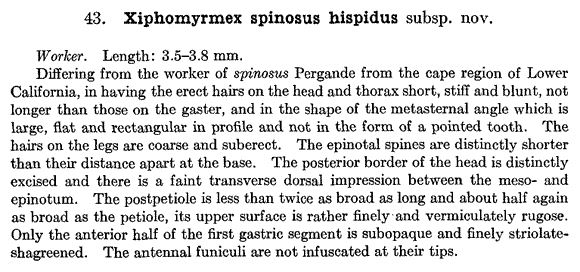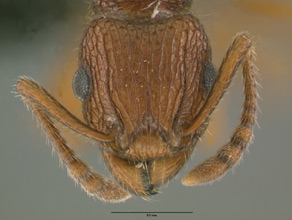- Identification
- Tetramorium are set apart from similar Myrmicinae by the large pit-like structure that surrounds the antennal insertions. This is most noticeable in the arrangement of the posterior portion of the clypeus, which drops down almost vertically at each side to form this structure. Tetramorium hispidum has an antenna with 11 segments and short, straight hairs (usually stubble like and shorter than the maximum diameter of the eye) on the top of the pronotum and the upper frontal carinae.
- Biology
- Creighton (1950) states the following concerning the biology of Tetramorium hispidum and Tetramorium spinosus: All of the nests which I have taken have been situated on upland plains or in the foothills of mountains at elevations between five and six thousand feet. The colonies are small, seldom containing more than a hundred individuals and the insects are not particularly active. According to Wheeler the workers forage singly but this is certainly not always the case. The nest is frequently surmounted by a small crater, especially when it is constructed in light soil, but in coarse soil the crater is often absent. The insect appears to be carnivorous and is not believed to store seeds.
- additional biology notes...
- Distribution
- Range
- United States. Southern Arizona, western Texas and New Mexico.
- Navajo Reservation Records
- Samples being processed.
- Etymology
- Morphological. A reference to the short hairs on the head and prontum. hispid (L.) = Hairy, bristly.

- Literature
- Creighton, W. S. 1950. The ants of North America. Bulletin of the Museum of Comparative Zoology at Harvard University. 104:1-585.
- Wheeler, W. M. 1915. Some additions to the North American ant-fauna. Bulletin of the American Museum of Natural History. 34:389-421.
- A note about these publications. The literature cited here is not meant to be an exhaustive list of papers published about this species.
Page authored by David Lubertazzi and Gary Alpert


